New for 2024

Celosia Ruby Parfait
Magenta-purple feathery spikes blooming for mid-summer until frosts. Excellent cut flower:keeps for a very long time. Makes beautiful fall decorations. Height: 60 to 90 cm. Easy to grow. Similar to Flamingo Feather but with darker flowers.
Packet of 40 seeds: $2,49




Celtuce 38
A lettuce grown for its large, thick stem, which can be eaten raw or cooked. All you have to do is peel it and then use its crispy core. The flavor is stronger than that of lettuce leaves but it's hard to describe (... maybe a bit like asparagus (?)). The seeds we offer are from the Celtuce 38 cultivar, which has better resistance to summer heat and bolting. The lettuce shown on the first 3 thumbnails was harvested on August 3rd: the stem was then 4 cm wide and it was still good to eat (non bitter). Popular in oriental cuisine, sometimes available at some specialty stores in Montreal (right thumbnail). Also called Chinese Lettuce, Asparagus Lettuce. Lactuca sativa var. asparagina.
Packet of 0.5 g: $2,99
 Chervil
ChervilDelicate foliage with a slight anise flavor. Can be used fresh or dehydrated to flavor sauces, soups, salad dressings, grilled foods, etc. You can start harvesting the leaves about 6 weeks after sowing. The plant usually begins to set seeds towards the end of the season; the leaves then takes on beautiful purple and golden hues. You can do successive sowing. Prefers partial shade and moist soil. 30 to 60 cm tall. "French Parsley".
Packet of 100 seeds: $1,99
 Marigold Lemon
Gem (Tagetes
tenuifolia)
Marigold Lemon
Gem (Tagetes
tenuifolia)Compact mounds covered with a myriad of small, long-lasting yellow blooms. The finely divided foliage gives off a scent that is both lemony and musky. It is therefore possible to use this plant as a seasoning, although its taste is a bit unusual. A good comparison would be its next of kin in the marigold genus, namely Tagetes minuta (Huacatay or Black Peruvian Mint), which shares some of its taste profile (musky, citrusy and minty). The whole plant can be harvested just before the first frost to be dried indoors (the dehydrated leaves retain their aroma). Obviously, this plant can also be cultivated solely for its ornamental qualities and to attract pollinators. Blooms from July until frosts. Height: about 40 cm tall. Flowers: 2,5 cm. Good drought tolerance. Full sun.
Packet of 40 seeds: $2,49




Melon Pear (Solanum muricatum, Pepino Melon, Pepino Dulce)
The Melon Pear, aka Pepino Melon, is a native of the Andes producing wonderful fruits with a flavor reminiscent of honeydew melon and pear. Yellow flesh, tender and very juicy. Potato foliage with flowers similar to those of eggplants. Fruits are oval to elongated, pale yellow to dark purple, with varying degree of purple striping*. Plants tend to crawl and may need staking. Approximately 50 cm tall. Also called Pepino Dulce Popular fruit in Peru. Germination +- 60%. Limited supply.
Sold out.
* Fruit shape and size vary from plant to plant and so are the leaves (from pale green to dark purple) and flowers (white to purple). The dark-leafed plants grows the long striped fruits. Plants are self-fertile but pollination can sometimes be an issue for some of them. Grow more than one plant if possible.
It is possible to grow melon pears in Quebec if you start sowing early, either in February or March. It is very easy to make cuttings from this plant. You can clone it almost indefinitely. Just snap a branch and put it in water (or stick it right in the ground). Potted plants overwinter very well in a garage or a cold room. Even if they seem dead, they can grow back new shoots in spring. Obviously, greenhouse cultivation would be best for this plant as it allows for a longer growth period and for more fruits to ripen in the fall. The unripe fruits are edible; in fact some people prefer them at this stage and use them in salads, the same way as cucumbers. You can put the unripe fruits in a bag with some apples and they will slowly start to ripen and smell sweet.
 Melon
Sakata
Sweet
Melon
Sakata
Sweet Japanese variety producing tiny honeydew melons the size of a grapefruit. Very sweet flavor. Very pale green flesh, with a particularly firm and crispy texture. Thin skin that does not need to be peeled (they can be eaten whole). When fully ripe, these melons turn yellowish and begin to give off a sweet scent. Vigorous vines. Early: 75 days.
Packet of 20 seeds: $2,99

Mexican Tarragon (Tagetes lucida)
This plant of the marigold genus features an aromatic foliage with a scent reminiscent of tarragon and anise. The plant also produces bouquets of small, 1-cm yellow flowers. The small leaves can be used either fresh or dried; but if you cook with them, make sure to add at the end of recipe (taste fades out with heat). Plants are slender, so pinch to promote side branching and/or plant them close together (20 cm). Blooms start in July and last late into the season. Well-drained soil and full sun preferred. This species has a goof tolerance to drought and heat. About 60 cm tall.
Packet of 25 seeds: $2,49



Nasturtium Jewel Mix
An easy-to-grow annual producing flowers in shades of yellow, orange and red. Ideal for pots, hanging baskets and borders. Blooms quickly. Sow directly outside. The flowers are edible and have a peppery flavor reminiscent of watercress. The leaves can also be eaten (choose the young ones). Dwarf variety which can still reach sometimes over 30 cm long (the plants crawl on the ground or fall over the pots). Tolerates shade well.
Packet of 30 seeds: $2,49


Nightshade Red Berry (Red Nightshade, Solanum villosum ssp. alatum)
Variety with bright scarlet, fully edible fruits, which can be eaten fresh or processed. When fully ripe, their sweet taste is reminiscent of grape, persimmon or kiwi. After harvest, you can let them ripen inside for a few days: their taste seems to get even better. These berries would probably make some tasty jams, either used alone or with other small fruits, such as ground cherries. Fruits are small (0,8 cm) but harvest is continuous and extends from August until frosts. This species is quite large compared to other huckleberries, sunberries and the such; it can reach sometimes over 1,8 m tall. About 70 days.
Packet of 50 seeds: $2,99

Parsnip
Smooth roots with fine texture and sweet taste. About 30 cm long. Sow directly in the ground in spring once the soil has warmed up. Roots are harvested in fall, most often after a frost, which is said to enhance taste. Seed germination is long and can take 2 to 4 weeks. The variety we offer is Harris Model. 125 days.
Packet of 2 g (approximately 400 seeds): $1,99
 Physostegia
(Physostegia
virginiana)
Physostegia
(Physostegia
virginiana)Perennial with pinkish flower spikes blooming in July and August About 40 cm tall. Grows in bunch. Tolerates wet soils and very cold weather (zone 3). Also known as Obedient Plant.
Packet of 50 seeds: $1,99
Popcorn type with tiny yellow kernels that can be popped into a mini popcorn about 2 times smaller than normal (0.8 to 1.5 cm). The long, slender cobs are unique and beautiful; they look like yellow carrots. They are about 15 cm long by 3 cm wide. The plants are quite large, reaching almost 3 m tall. To make novelty popcorn or for decorations.
Packet of 40 seeds: $2,49
 Popcorn Mix
Popcorn MixMixture of several popcorn types: white, yellow, red, purple and blue, with some intermediate tones. You will get different combinations of multi-colored cobs. To make popcorn or for decorations.
Packet of 40 seeds: $2,49

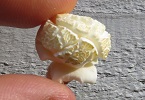
Popcorn Mushroom
There are two types of popcorn: the "butterfly" and the "mushroom" type, depending on whether the popped kernels are flared (butterfly) or rounded (mushroom). So here is a mushroom variety, with kernels that will pop into more rounded flakes (some of them will even be literally mushroom-shaped (right thumbnail)). Good quality popcorn: pops easily to produce good-sized flakes (2 cm), with a more consistent texture and a more pronounced taste than the commercial one. Commonly used to make caramel popcorn. Plants are 2 m tall with medium-sized ears and yellow kernels. 110 days
Packet of 40 seeds: $2,49
Popcorn variety with beautiful ears of shiny red kernels. You can remove kernels to make popcorn or use it whole for decorations. Plants are 2 m tall and with medium size ears, about 20-25 cm long.
Packet of 40 seeds: $2,49

Pepper Aji Limo (Aji Limo Rojo)
Peruvian variety traditionally used with fish (ceviche, tiradito) and beef (lomo saltado), and also to prepare ajis (Peruvian hot sauces). The bright red fruits are slightly variable in shape, more or less elongated and wrinkled, and with a waxy skin. They are between 5 and 9 cm long. This pepper is quite hot, with taste reminiscent of habanero. From Peru. About 95 days.
Packet of 15 seeds: $2,99
Although it is called "aji" and it looks like a C. baccatum, this variety is indeed a C. chinense. Not to be confused with Aji Limon, which is a C. baccatum with yellow pods. There seems to be different colors of Aji Limo out there; the one we offer is the red subcultivar (rojo).C. baccatum.


Pepper Aleppo
Middle Eastern variety used dried to season various dishes. Peppers are 10 to 13 cm long, pleated, turning burgundy red at maturity. Once dehydrated, they take on a fruity arroma reminiscent of raisins. Aleppo pepper powder is sometimes mixed with sumac or zaatar (a blend of ground thyme, sumac and toasted sesame seeds). Popular in Armenia, Turkey, Lebanon and Syria. Medium heat. Also called "Halaby" and "Pul Biber". 80-90 days
Packet of 15 seeds: $2,99

Pepper Carolina Reaper
The Carolina Reaper was the hottest pepper in the world from 2013 to 2023, with a scorching heat reaching up to 2,2 million SHU (average:1,6 million). In other words, it could be up to 20 times hotter than a habanero. So please use with caution. The 3 to 4-cm warthy pods often dipslay a "stinger". A selection of Ed Currie in South Carolina. About 120 days.
Packet of 10 seeds: $3,49.
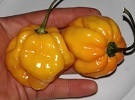
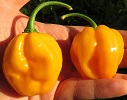

Pepper Habanero Big Sun
A large habanero, up to 5 cm long. Click thumbnails for details. Ripens from green to bright yellow, then turns golden yellow with some orange hues. Wrinkled pods, variable in shape, globular to slightly elongated. Skin is unusually shiny and almost looks like it's been polished. Taste is fruity and very, very hot! Officially, Big Sun is at the same heat level as a habanero but after tasting it, I believe it could be twice as hot. Unripe pods can be pale green or dark green, but all turn golden at maturity. Similar to Burkina Yellow. 90 days.
Packet of 15 seeds: $2,99

Pepper Lesya
.
Sweet type with superb heart-shaped or top-shaped pods, with very thick, firm and crunchy flesh. Good sweet flavor. The plants covered in red fruits at the end of the season are simply magnificent. Variety native to Eastern Europe. 75-80 days.
Packet of 15 seeds: $2,99

Radish Watermelon
Large white radish, 7 to 8 cm in diameter, with a beautiful pink center. Can be eaten fresh or cooked. Makes very nice slices. Can also be pickled. Pungency seem to decrease as radish grows (so pick them larger for a softer taste). 60 days.
Packet of 2 g: $2,49

Squash Zucchini Cocozelle
Italian variety with dark green fruits covered with pale green lines. Preferably harvested between 30 and 40 cm long. Tender flesh with a fine, delicate flavor. Ancestral variety dating from the 19th century. Also known as Cocozella di Napoli. 55 days.
Pack of 20 seeds: $2,49



Sweet Lupine (Lupinus albus, White lupine (sweet cultivar, "sweet lupine")
Variety of lupine yielding edible seeds with a high nutritional value. Popular in the Mediterranean countries, where it is known by various names (lupini, tremoços, etc.). Lupine seeds are cooked like dried beans and then preserved in brine. They are a popular snack in Portugal and often served with beer. The plant produces flower spikes similar to those of decorative lupins. These are followed by pods similar to those of soybeans, each containing 2 to 7 seeds of about 1 cm. The variety we offer is the sweet lupine, without bitterness. So there is no need to soak the seeds for days (they do not contain any bitter-tasting compounds). The color of the flowers is generally white, but it is variable and can range from blue-purple to white, including intermediate and/or two-tone shades. Prefers a well-drained soil. Full sun. Height: 1 to 1.2 m. Shows some tolerance to cold*. 130 days.
Packet of 20 seeds: $2,99
Lupine (L. albus) is certainly one of the most nutritious plants in the world, with seeds containing up to 40% protein as well as all essential amino acids.
Lupine has already been successfully cultivated on a small scale in Quebec. Links to info in French: The rise of lupine in Quebec 2nd article 3rd article
Lupine is often compared to soybean because of its high protein content and it is often called "soy of the north". On the other hand, unlike soybean, it does not contain phytoestrogens.
. * Purportedly, seeds could withstand temperatures of -6 C to -8 C during germination. This means you could sow them outside quite early in the spring and thus save time, considering the long growing cycle (130 days). Some recommend sowing outside in early May or at the same time as peas (= end of April, in southern Quebec). The safest method is to start the seedlings indoors, in April, and planting them outside in late May (just make sure not to disturb roots (preferably use peat cups)).


Tarwi (Lupinus mutabilis)
Tarwi is grown in the Andes for its highly nutritious seeds, similar to those of the white lupine. The plant produces flower spikes releasing a delicious sweet scent, followed by pods similar to those of soybeans, inside of which we find the 1-cm white seeds. It is preferable in Quebec to start seedlings indoors a few weeks before last frost in order to get a decent harvest.* Sun to partial shade. 100 cm tall. Grows well in poor soil, fixes nitrogen. Also called "Chocho" or "Andean Lupine". The largest production of Tarwi in the world is located around Lake Titicaca, at 3,800 m elevation. Lupinus mutabilis. 130 days.
Pack of 20 seeds: $2,99
. * However, make sure to not disturb roots when planting seedlings outside. Sow preferably in peat pots.
Sowing directly outside is riskier, given the long cycle of this plant (130 days).
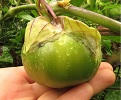 Tomatillo
Gigante Verde
Tomatillo
Gigante VerdeThis variety has a softer taste, less acidic and less tangy. It is also claimed to contain 50% more sugar (which makes sense). Since its taste is not as strong as let's say a "standard salsa-type tomatillo", it can be more readily used like a fresh fruit. You can cut it into pieces or slices and mix it with other fruits or vegetables. This variety also stands out for its large-size fruits (6 cm). Height: 1 m. Full sun.
Packet of 20 seeds: $2,49


Tomato Micro Tom
Tiny tomato plants, barely reaching 15 cm tall. Perfect for small pots (10 cm), flower boxes and indoor growing. Small red tomatoes, 1.5 cm in diameter. Determined. 85 days.
Packet of 15 seeds: $2.99

Tomato Pineapple Pig
Large yellow tomatoes with low acidity and sweet flavor. Creamy flesh. Core turns pink when fully ripe. Pale yellow skin, striped with a few green lines. 200 to 400 grams. A selection of Bradley Gates in California. Indeterminate. 85 days.
Packet of 10 seeds: $2.99
High sugar variety, with a Brix index reaching up to 10 (which means 10% sugar). Bright red tomatoes, striped with orange lines, tapered in shape and reaching 6 to 8 cm long. This strain is semi-determinate, meaning it will eventually stop growing and producing fruits, but this is process will be delayed compared to a "full" determinate. The plants are also rather modest in size and reach up to 1 m; so they can be grown in pots. No need for pruning. Good production. Early: 65-70 days. Semi-determinate.
Packet of 10 seeds: $2.99

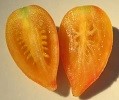

Tomato Sweet Cream
Exceptional taste, particularly sweet and fruity! Exquisite. An all-time favorite. Good quality fruits, quite uniform, showing good resistance to cracking. Hold well on the plants. Keeps also well after harvest. Clusters of 5 to 7 tomatoes, 5 to 8 cm long. Golden skin with orange streaks. If you like sweet tomatoes, you will love this variety. A selection of Bradley Gates in California. Indeterminate. 75 days.
Pack of 10 seeds: $2.99

Turnip Purple Top
Large white turnip with a purple top. Can grow up to 12 cm in diameter. White flesh, tender and crispy. Mild peppery flavor reminiscent of radish. Keeps well after harvest. "Purple Top White Globe". Turnips are best grown in spring and fall. 50 days.
Packet of 1 g (approximately 300 seeds): $1,99
 Turnip White
Egg
Turnip White
Egg Small turnip, round-oval, with tender and juicy flesh. Slightly peppery flavor reminiscent of radish. This variety can be harvested when it is the size of a golf ball, or later, when it reaches 7 cm in diameter. It can be eaten fresh or cooked. Cultivar "White Egg". Turnips are best grown in spring and fall. 50 days.
Packet of 1 g (approximately 300 seeds): $1,99
![]() Home page
Home page
![]() Return to catalog
Return to catalog
![]() Page en français
Page en français